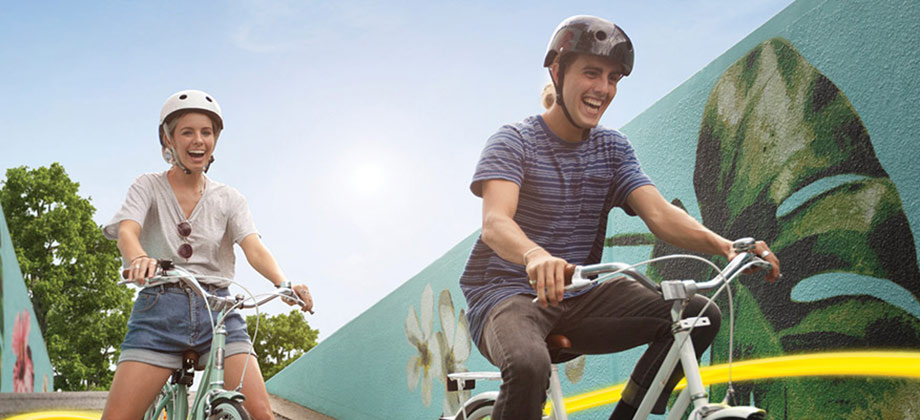Walking and cycling
The human body is unlikely to survive an uncushioned impact with a vehicle travelling at more than 30km/h (Vicroads 2008, p12).
Where traffic moves at higher speeds it is vital that we separate pedestrians from vehicles by way of off-road paths and pedestrian facilities.
Where pedestrians have to cross roads, the crossings that are provided need to be of a high standard.
Across Australia, pedestrians account for approximately one quarter of all road deaths in metropolitan/urban areas (Australian Transport Council 2008, p48) and so managing pedestrian behaviour through enforcement and engineering is especially important in this environment.Similarly to pedestrians, bicycle riders are vulnerable road users and are much more likely to be injured in the event of a crash than motor vehicle occupants (Queensland Transport 2008, p25).
European research suggests that the risk of being killed per traffic kilometre travelled is more than seven times higher for cyclists than for car occupants, with the severity of injury sustained in crashes also higher (Townsend and Avenoso 2008, p30).
It is sometimes argued that cycling and walking should be discouraged, as they are less safe modes of transport than a car (Townsend and Avenoso 2008, p27). However, research suggests that the public health advantages of walking and cycling, e.g., a healthy lifestyle through regular exercise, outweigh the risk of death or injury from road crashes (Townsend and Avenoso 2008, p27).
Therefore, in order that riders can be kept safe while still maintaining a level of mobility, there is a need to provide suitable separate off-road cycling facilities, especially where the other options for cyclists are riding on higher-speed roads where injuries sustained in crashes will be more severe.
Bicycle helmets substantially reduce the risk of death or brain injury for cyclists (Australian Transport Council 2008, p48) and still need to be actively promoted and policed to encourage compliance.
Providing a safe co-existence between cyclists, pedestrians and other traffic through better education, enforcement and engineering – particularly in busy urban environments – is, and will continue to be, an ongoing challenge for all road users, agencies and authorities.
Under the Australian Road Rules a driver of a motorised wheelchair is also classified as a pedestrian and must follow the same rules as pedestrians, e.g., using a footpath where provided.
These devices are growing in popularity and some sections of the community may not be aware of, or understand, their responsibilities for the safe and legal use of these mobility devices, e.g., registration and insurance issues. Users of these devices commit an offence if they:
- Use the motorised wheelchair while having a blood alcohol level of 0.05 or above
- Travel faster than 10km/hour
- Obstruct the path of any driver or another pedestrian
RACQ Presentation at the Asia Pacific Cycling Congress 2015
RACQ research about drivers and cyclists shows that others breaking road rules annoys everybody, but that many riders and drivers are not aware of the road rules.
APCC Presentation (PDF 1,643KB)
RACQ and Bike QLD Road Rules Brochure
In late 2015, RACQ developed a brochure with Bike Queensland to inform bike riders and motorists of the road rules applying to bikes in Queensland.
RACQ road rules brochure for bikes (PDF 2.48KB)
-
- Continue educational campaigns to inform motorists, pedestrians and cyclists on how to share the road safely with each other.
- Continue to support education with enforcement activities that serve to encourage safe behaviours and compliance by all pedestrians, cyclists, motorists and users of wheeled recreational devices and motorised wheelchairs.
- Provide separate, adequately signed cyclist facilities on new and existing roads, where practicable, to reduce risk of interaction with motor vehicles in the traffic stream.
- Improve awareness among patrons of licensed premises about the dangers of walking intoxicated and raise community awareness about the risks of drink walking through publicity programs.
- Provide engineering treatments, incorporating innovative approaches where appropriate, to reduce risk and/or separate pedestrians from road traffic at locations of high pedestrian activity, e.g., overbridges near schools, variable speed signs in strip shopping centres.
- Monitor trends in the use of motorised wheel chairs and whether any negative road safety issues are arising.
- Improve the planning and implementation of local pedestrian and cycling safety initiatives and facilities across the community, e.g., off-road networks and routes that run parallel to arterial roads leading to business centres and ensure the quickest routes are also the safest.
- Improve professional awareness of how to assess medical fitness for potential users of motorised wheelchairs and improve availability of information assisting health practitioners.
- Improve availability of information relating to safe use of motorised wheel chairs for the users of these devices.
- Install lower speed limits in areas with higher pedestrian activity, which operate when needed.
- Encourage an increased take-up of vehicles with features that do less harm to pedestrians, and review Australian Design Rules to help ensure that vehicle designers consider pedestrian safety standards.
- Improve cyclist helmet use rates and cyclist conspicuousness through public awareness campaigns.
Review penalties for cycling offences with a view to matching monetary fines to seriousness of offences and raising awareness of rights and road safety responsibilities, e.g., appropriate training programs.
-
Australian Transport Council 2008, National Road Safety Action Plan 2009 and 2010, Australian Transport Council, Canberra, ACT, Australia.
Data Analysis Unit 2009, Personal Correspondence to RACQ, 03/06/09, Queensland Transport, Brisbane, QLD, Australia.
Queensland Transport 2008, Queensland Road Safety Action Plan 2008-2009: safe4life, Queensland Government, Brisbane, Queensland, Australia.
Townsend, E. and Avenoso, A. 2008, Road Safety as a right and responsibility for all: A Blueprint for the EU’s 4th Road Safety Action Programme 2010-2020, European Transport Safety Council, Brussels, Belgium.
Vicroads 2008, Victoria’s Road Safety Strategy: Arrive Alive 2008 – 2017, Vicroads, Victoria, Australia.
